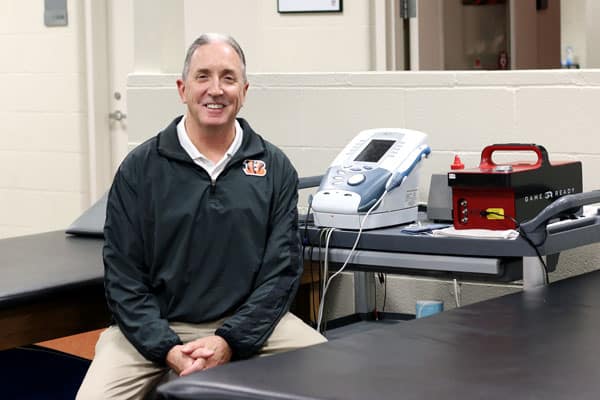Training camp opens in a few short weeks and Paul Sparling finds himself stopping by the equipment room at Paul Brown Stadium, a familiar site that has become a second home for the thirty-eight-year NFL athletic training veteran.
Soon, those striving to make the forty-five-man roster of the Cincinnati Bengals will arrive in the equipment room, where, at times, they might spot their head certified athletic trainer folding towels right alongside equipment managers and interns. “I like to show them up, folding towels faster than they can,” Sparling says with a laugh. “I tell my wife I can still do the whitest whites and the brightest colors.”
It may seem odd at first for players and staff to see Sparling taking on laundry duties, considering he is enjoying one of the longest tenures among head certified athletic trainers in the NFL. However, the Ohio native’s roots were built on a humble foundation, and little has changed today. “Sometimes players will see me in the equipment room, and they’ll look at me and go, ‘What are you doing?’” he says. “I tell them it’s always important to remember your roots and remember where you came from; you’re never too good to go back and do it again.”
Years ago, Sparling enjoyed a surreal thrill when he was a student assistant to the equipment manager for the Bengals while still enrolled at Wilmington College. Back then, the Bengals would hold their six-week training camp at the Ohio college, and when Wilmington’s head trainer, Roger Tewksbury, offered the laundry duty position to Sparling, the 1981 alumnus says he jumped at the opportunity. But Sparling’s athletic training days actually predate college and even high school.

In seventh grade, Sparling knew he had a future in sports. “I was too small to play football, too short to play basketball, and I couldn’t hit a curveball,” he says. “That left me with few options, but I still wanted to be involved in sports in some way, shape, or form.”
That’s when Odell Pursifull, the track coach and physical education teacher at his junior high, asked Sparling if he was interested in becoming an athletic trainer. But it was 1972, and Sparling wasn’t sure exactly what an athletic trainer was, as the profession was in its infancy. Eventually, he agreed, and Pursifull paid ten dollars for Sparling to take a home correspondence course with Cramer Products, which makes several athletic training products. Sparling fell in love with the courses and still has the notebook that outlines chapters of information on muscle strains, stretching, and other common athletic ailments. “From that point on they nicknamed me ‘Doc’ in junior high and in high school,” Sparling says.
Although he sought the athletic spotlight at a young age, Sparling admits he is not a sports fanatic. His father was an optometrist, a fighter pilot in World War II, and a skilled handyman, which instilled a tireless work ethic in his son. As he got older though, Sparling learned a strong work ethic wasn’t enough; he had to be a teacher as well.
“I am first a husband, a father, and a son, and by the way, I happen to be the head certified athletic trainer for the Cincinnati Bengals.”
His first experience teaching came during his sophomore year of high school, when he was working as a student athletic trainer with his high school’s head football coach, Hank Schneider, a former fullback with the University of Cincinnati. On a particularly hot and humid Ohio day, Sparling recognized the players needed water, a concept that today seems like common knowledge, but was once deemed to make players “soft.”
Despite the notion, Sparling walked onto the football field with a couple of jugs of water, took a seat by an oak tree for shade, and waited for Schneider to come over. “He said, ‘You’re planning on watering the tree with those, right?’” Sparling recalls. The sophomore quickly explained that the players needed water breaks to prevent dehydration. “He looked at me, and I thought my athletic training career had already come and gone,” Sparling says. “But he respected me, and we started having water breaks. That was one of the things that tested me to see if I had what it took to do it, the smarts to do it, and the savvy to do it in a way that didn’t upset people.”
From then on, Sparling was the student athletic trainer for the rest of the football, basketball, and track and field seasons. By the end of high school, Sparling earned nine letters and knew a career that mixed his passion for sports and helping others would be on the horizon. In fact, during a casual conversation with a friend in the training room, he unknowingly predicted his future career.
“I said, ‘Someday I think I’d like to be the head trainer for the Cincinnati Bengals.’ It just came off the top of my head,” Sparling says. “I hadn’t really thought it out, but it seemed like a neat thing. I never dreamed that it would have happened.”
After high school, Sparling enrolled at Wilmington because he loved the campus size and location. Plus, the school was starting an athletic training program, and it just so happened to be the home of the Bengals’ training camp. Eventually, he was offered a role to do laundry for the Bengals through a Wilmington program, and because of his machine-like work ethic, he was asked to help in the equipment room. During that time, he ended up working alongside Marv Pollins, the team’s original head athletic trainer from when the team was established in 1968, and assistant trainer Bill Connelly.
Upon graduating from Wilmington, Sparling took a job with a sports medicine clinic in Cincinnati that was affiliated with the Bengals. It not only allowed him to continue working with the team, but it also led to him becoming the full-time assistant athletic trainer in 1985.
Hall of Fame Honors
Paul Sparling’s opportunity for a formal thank you to his parents and mentors came in 2015, when he was inducted into the Wilmington College Athletic Hall of Fame as an athletic trainer.
“To have that opportunity, having been elected into the hall of fame at Wilmington College, to me, it brought things full circle to be able to tell them how much I appreciated what they did for me and the sacrifices that they made for me,” he says.
Sparling was also recently nominated for induction into the Ohio Athletic Trainers Association (OATA) Hall of Fame. The OATA is a nonprofit organization dedicated to the healthcare needs of the physically active to ensure that athletes at all levels receive immediate, professional, and quality healthcare.
In 1991, Pollins announced his retirement, and Sparling was asked to become the head certified athletic trainer. After some contemplation and inspiring words from his father, Sparling agreed to take the role. Like with any career, he says there were times when he second-guessed his decision—especially when he has had to be the bearer of bad news, informing the organization about injuries—but he quickly adjusted to his new responsibilities, as the role extends beyond treating and preventing athletic injuries. Sparling and his team also tackle player education, injury evaluation, first aid, treatment, and rehabilitation on a daily basis.
His team also helps to evaluate prospective draft picks and free agents from an injury standpoint. In fact, the entire organization relies on the team to assess the business risk in signing players. “The reports we give to the owners, scouts, and coaches after we evaluate somebody are like a sheet of car facts,” Sparling says, adding that it includes a player’s injury history, time to heal, and his probability of repeat injuries.
Sparling notes that the position has changed dramatically since 1992. Back then, about 80 percent of his time was in the training room, conducting hands-on therapy, whereas now he compares his role to that of an orchestra conductor.
“I know how to play the instruments; I’ve played them before,” he says. “But it’s important that I make sure that all of the medical staff is playing from the same sheet of music and making good music that is coordinating and collaborating with all the different team physicians, the different medical consults we use, the athletic training staff, and the strength and conditioning staff.”
The expectations are also greater, as his responsibilities now include education and injury prevention. Before the start of each season, Sparling will conduct educational sessions with athletes and coaches to discuss topics including steroids, prescription medication abuse, the NFL’s concussion protocol, and banned supplements that if used could make players subject to suspension.
The NFL has made concussion prevention a primary focus in recent years, but Sparling explains that the Bengals had already been enforcing similar policies for years. “For example, the independent neurological consultant that the league mandated eight or nine years ago—we had been doing that probably fifteen years ago,” Sparling explains. “We try to stay ahead of the curve as much as we can.”
Despite the prestigious title, being the head certified athletic trainer for the Cincinnati Bengals is not something Sparling advertises. The fact that he has worked more than 750 games for the NFL—or that there are currently only two other head athletic trainers in the NFL who have worked longer than him—just isn’t a conversation starter that he’s comfortable with. “I tell people this is not who I am; it’s what I do,” he says. “I am first a husband, a father, and a son, and by the way, I happen to be the head certified athletic trainer for the Cincinnati Bengals.”

